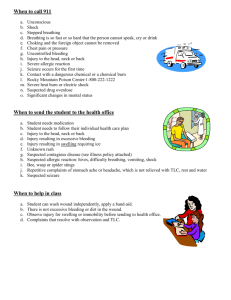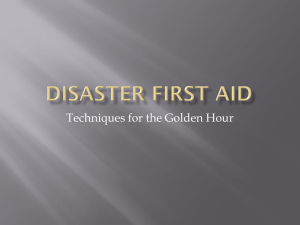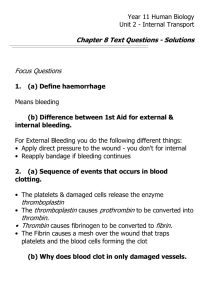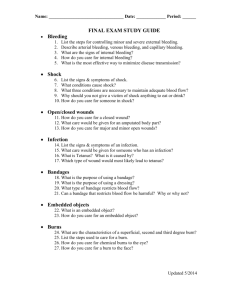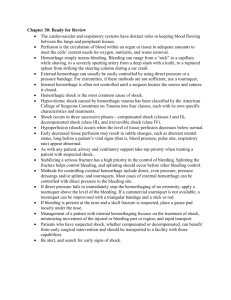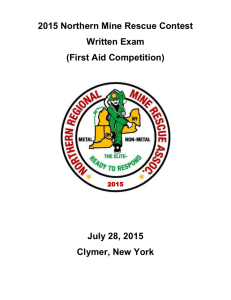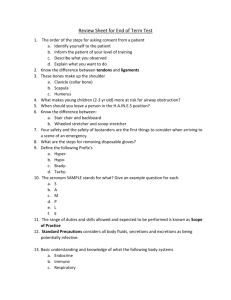Bleeding And Shock
advertisement
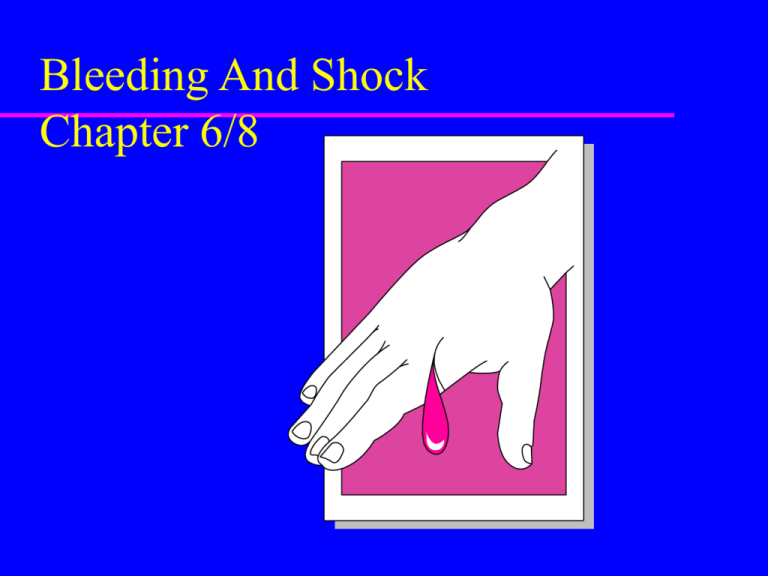
Bleeding And Shock Chapter 6/8 Sources of External Bleeding Arteries Veins Capillaries Arterial Bleeding Most serious / arteries are usually deep in the body Rapid and profuse blood loss Bright red / spurts Less likely to clot Must use external means to stop blood flow Venous Bleeding Steady flow / bluish-red May be profuse More easily controlled Veins are closer to the body surface Can be serious Capillary Bleeding Easily controlled Blood oozes –Road rash Blood Vessel Spasm Severed arteries – Artery draws back into the tissue – Artery constricts and slows bleeding Partially severed arteries – Associated with greater blood loss – Example: amputations Definitions Hemorrhage: Rapid blood loss – Adult: 1 quart may lead to shock – Child: 1 pint loss of blood Dressing – A protective covering for a wound – p.150 Bandage – A material used to hold a dressing in place Dressings Used to control bleeding Prevents contamination Dressings should be: –Sterile –Larger than the wound –Thick, soft, compressible –Lint free (no cotton balls) Types of Dressings Gauze pads Adhesive strips Trauma dressings Improvise Donut shaped Dressings Application – Wash hands – Dressing should extend over edges of wound – Do not touch dressing surface that is to be next to the wound – Place medications directly onto pad – Cover with a bandage Removal of Dressings – Soak “stuck” dressing in warm water Bandages Are Used For: Holding dressings in place Applying pressure Prevent or reduce swelling Provide support or stability Application of Bandages Leave toes and fingers exposed if possible – Bandage too tight? Check for color, circulation, temperature Wrap towards the heart – Small end of bone to large end Types of Bandages Roller gauze Improvised Triangular Cravat Adhesive / paper tape Adhesive strips P.150-152 Tourniquets –Rarely recommended –Damages nerves and vessels Types of Wounds And Application of Bandages And Dressings Will Be Addressed Later Someone Has Cut Their Leg: What Should You Do? (external bleeding / depends on severity) Call for help when necessary Protect yourself from bodily fluids Expose the wound Apply sterile gauze pad (dressing) Apply constant, direct pressure for 10 minutes (don’t peak) Cut Leg If dressing becomes blood soaked – do not remove dressing, add others over it After 10 minutes, if bleeding persists – apply pressure harder and over a wider area for 10 more minutes (seek help) Additional Options Elevate limb above heart level Apply pressure at a pressure point When bleeding stops: – Apply pressure bandage (roller gauze) – Wrap towards the heart Problem Bleeders Hemophiliacs Aspirin When Not To Apply Direct Pressure Protruding bone Skull fracture Embedded object May use a donut shaped pad Internal Bleeding Look for abdominal: –Pain –Tenderness –Rigidity –Bruises Internal Bleeding Look for: –Black stools –Bright red stools –Cough or vomit with blood –Fractured ribs or bruises Internal Bleeding: What To Do Monitor ABC’s Lay on side if appropriate (expect vomiting) Treat for shock – Raise legs 8-12 inches (if conscious) – Cover victim Bruises: Ice, ace wrap, elevate Shock Occurs when the circulatory system fails – Resulting in inadequate blood flow to some part of the body A MAJOR CAUSE OF DEATH !!! Shock #2 Always treat injured victims for shock Shock: –can be prevented –cannot be reversed Types of Shock Cardiogenic –Heart fails to pump sufficient blood supply Types of Shock Neurogenic – Spinal cord damage – Drug overdose – Vessels dilate – Blood supply insufficient to fill vessels Types of Shock #2 Septic –Result of a bacterial infection –Vessels lose ability to contract Types of Shock #3 Hypovolemic (Fluid Loss) –Most common type »Blood loss »Dehydration from vomiting, diarrhea or profuse sweating Shock: What To Look For Pale, cold, clammy skin Altered mental status – Rapid breathing and pulse Unresponsiveness Nausea and vomiting Shock: What To Do First, care for life threatening injuries If the face is red, raise the head, – (injuries to upper half of body – raise the upper half of body) If the face is pale, raise the tail. (injuries to lower half of body, raise the lower half of the body) Shock: What To Do #2 conscious and appropriate, place victim on back, raising legs 8-12 inches If EXCEPT those needing ½ sitting position (listed on next slide) Cover Do victim, over and under not let victim eat or drink – May suck on wet cloth Shock: When To Place In A Half Sitting Position Difficulty breathing Head injuries (when appropriate) Strokes Chest injuries Penetrating eye injuries Heart attack Unconsciousness Anaphylaxis or Anaphylactic Shock Massive allergic reaction by the body’s immune system Causes Of Anaphylactic Shock Medications » Penicillin and related drugs, aspirin, sulfa drugs,meds and alcohol Foods and food additives – Monosodium glutamate, peanuts Plant pollens Bee stings Radiographic dyes Characteristics of Anaphylaxis Usually comes on in minutes / Peaks in 15-30 minutes Sensation of warmth Intense itching of soles of feet and palms of hands Breathing difficulties Tightness and swelling in throat Coughing, sneezing, wheezing Tightness in chest Characteristics of Anaphylaxis #2 Increased pulse rate Swollen Nausea face, tongue, mouth and vomiting Dizziness Blue around lips and mouth Anaphylaxis: What To Do Check ABC’s – Use ice pack on bee sting Inject epinephrine (dilates bronchioles) – P.442 (hopefully victim will have some) – Inject in outside part of thigh, hold for 10 seconds – May need to repeat Get help immediately (float trip) Benedryl – too slow for major emergency, but worth a try
